Have you been considering workout at home without using the equipment? Read on to check out the workout at home without equipment that will suit you.
Before discussing the workout at home without equipment, let’s talk about workout at home and how best to engage in it.
Exercising at home involves physical workouts carried out indoors in one’s home, and are different from exercise done outdoors or in a fitness center or gym.
Why workout at home
The reason for exercising at home is for one to get the benefits of a physical workout like improved strength, balance, flexibility, endurance, and possible weight loss with or without the use of the equipment and in the privacy of one’s home.
The best way to workout at home
Exercising at home does not pose any greater risk of injury than training somewhere outside the home.
The difference is if you are working out in an exercise class or with a trainer elsewhere, there may be someone watching you and correcting you if your form is off or you appear to be training in a harmful way while at home, and no one to watch out for you.
Working with an online trainer who is a certified expert that can design customized workouts and help you improve your form by watching you and coaching you through video can be another great move for reducing the risk of injury.
Virtual trainers can also help you plan exercises to suit considering existing aches, pains, injuries, or other limitations you may have.
An additional benefit of selecting online workouts is that you can review the workout before doing it and research a move that you may not be familiar with in order to get more familiar with its right form.
Also, researching alternate exercises that may hit the same muscle ahead of time can make the workout go smoothly.
The Centers for Disease Control and Prevention (CDC) recommends that all adults get at least 150 minutes of moderate-intensity physical activity each week, in addition to two days per week of total-body muscle-strengthening activities.
After building a foundation, increasing your total exercise time or intensity comes with even greater health benefits.
Now let’s talk about the workout at home without equipment
Workout at home without equipment
Have you ever considered the possibility of workout at home without equipment? Here is the good news. We will share a few effective home exercises that do not require the use of any equipment.
But before the main workout session, you need to warm up for at least 10 minutes. Warming up is essential to elevate body temperature, metabolic rate, and oxygen uptake.
Check out the following warm-up routine:
- Neck tilt – 1 set of 10 reps
- Neck rotations – 1 set of 10 reps
- Shoulder rotations – 1 set of 10 reps
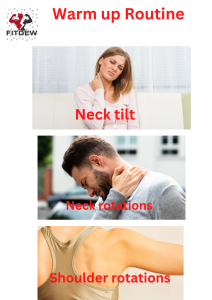
- Arm rotations – 1 set of 10 reps
- Waist circles – 1 set of 10 reps
- Side bends – 1 set of 10 reps
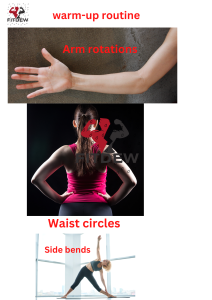
- Side lunges – 1 set of 10 reps
- Spot jogging – 3 minutes
- Ankle rotation – 1 set of 10 reps

Here are the workouts you can do at home without equipment
- Squats
A squat is a workout that one lowers the hips from a standing position and then stands back up.
Squats are considered necessary workout for increase in the strength and size of the lower body muscles as well as developing core strength.
Target: Quads, hamstrings, outer thighs (vastus lateralis), and glutes
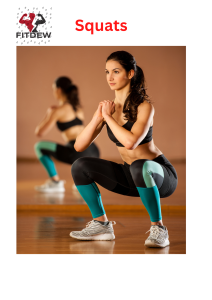
How to carry out Squats
- Stand straight with your feet hip-width apart.
- Draw your arms forward, perpendicular to the ground.
- Keep your entire body tight and flex your stomach.
- Breathe deeply and lower your butt as if you are sitting on a chair. Your thighs should be parallel to the ground.
- Ensure your bent knees are not overshooting your toes. Keep your body straight and firm.
- Come back to your original position and repeat from the beginning.
- Jump Lunges
A split jump also known as lunge jump is a form of exercise which focuses on the upper leg muscles, especially the quadriceps.
Target: Quads, hamstrings, and glutes

How to carry out Jump lunges
- Stand straight with your feet shoulder-width apart, chest out, shoulders rolled back, and abs engaged.
- Take a step forward with your right leg.
- Flex both your knees and lower your body. Stop when your right thigh is parallel to the floor.
- Push your body up into a jump. Simultaneously, bring your left leg forward and right leg backward.
- Land softly on the floor.
- Donkey Kicks
A kick is a physical strike using in unison usually with an area of the knee or lower using the foot, heel, tibia, ball of the foot, blade of the foot, toes or knee.
Target: Glutes, hamstrings, and hip flexors
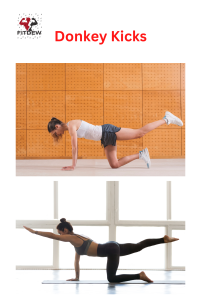
How to carry out donkey kicks
- Get on all fours.
- Lift your right leg off the floor.
- Keeping the knee flexed, kick your leg up toward the roof.
- Do this 15 times and then switch legs.
- This completes one set.
- Frog Jumps
Frog jumps also known as frog hops or the jumping frog exercise uses your bodyweight to activate muscle groups across your body.
Target: Quads, glutes, hamstrings, hip flexors, and calves
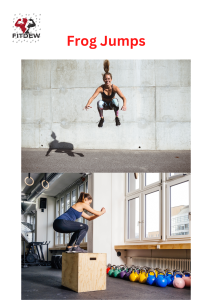
How to carry out frog jumps
- Stand straight with your feet wider than shoulder-width apart. Keep your chest up, shoulders rolled back, and core engaged.
- Flex your knees and do a full squat. Touch the floor with your fingertips.
- Get back up and take a small jump.
- Land softly on the floor and get into the full squat position.
- Wall Sits
A wall sit is a workout done to strengthen the quadriceps muscles. They are used as a primary strengthening exercise in many sports requiring strong quadriceps like fencing, ice hockey, sailing.
This exercise is also used as a disciplinary activity in the armed forces. It takes up little space, and can be administered easily in classroom settings to misbehaving soldiers-in-training.
Target: Quadriceps, core muscles, hamstrings, and glutes
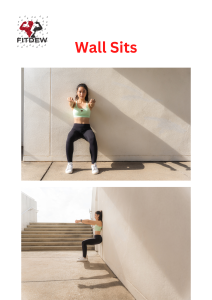
How to carry out wall sits
- Stand with your back to the wall and your feet 2 feet away from it.
- Sink your bottom down as if you are squatting.
- Hold this position for 30 seconds.
- Push-Ups
The push-up sometimes called a press-up in British English is done by raising and lowering the body using the arms.
Push-ups are a basic exercise used in civilian athletic training or physical education and commonly in military physical training. They are also a common form of punishment used in the military, school sport, and some martial arts disciplines.
Muscles targeted
Push-up primarily targets the muscles of the chest, arms, and shoulders, support required from other muscles results in a wider range of muscles integrated into the exercise.
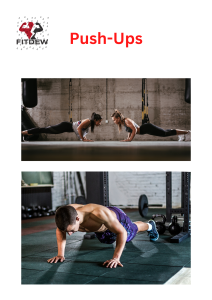
How to carry out push ups
- Go down on all fours, putting your hands a bit wider than your shoulders.
- Make your arms and legs straight
- Lower your body until your chest almost touches the floor.
- Pause, then push yourself back up.
- Repeat until the number of times you want
- Decline Push-Ups
The decline push-up is a bodyweight exercise that targets muscles throughout your upper body and lower body.
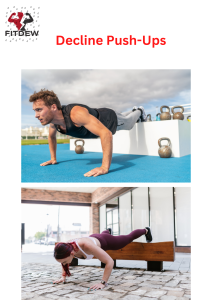
How to carry out Decline Push-Ups
- Place your feet on a secure elevated surface such as a bench or a low plyometric box with your legs straight and hip-width apart.
- Your toes should be flexed and in contact with the elevated surface.
- Your body should form a straight line as if you were performing a plank, and your hands should be slightly wider than your shoulders.
- Grip the floor with your hands and rotate your shoulders outward to engage your lats.
- Pre-tension your shoulders and hips while engaging your core.
- Squeeze your quads and glutes while keeping your ribs down and your pelvis slightly tucked.
- Your chin should remain tucked throughout the movement as if you were holding an egg under your chin.
- Pull your chest toward your hands by bending your elbows. Your shoulder blades should retract as you lower toward the floor.
- Lower your body until your upper arms are even with your back. Your elbows should be 45 degrees away from your body, and your wrist should be under your elbows.
- Pause for a second at the bottom of the movement.
- While maintaining your alignment, initiate the upward movement by squeezing your chest and straightening your elbows.
- Your shoulder blades should protract as you push to the top of the movement.
- Finish the movement by squeezing your chest and triceps.
- Triceps Dip
Triceps dip works your triceps, the three-headed muscle that runs down the back of your upper arm.
Dips can help balance out your arms if you tend to focus more on the muscles (your biceps).
Because the primary role of your triceps is to straighten your arms, when you strengthen that muscle, you also fortify your elbow joints.

How to carry out a Triceps Dip
- Stand between a set of parallel bars and grab each bar with your palms facing each other.
- Jump to lock out your arms, stacking your wrists, elbows, and shoulders to align your joints. Think about rolling the heads of your shoulders behind your collarbone, and fight the urge to shrug.
- Cross your ankles behind you.
- Pull your shoulders back and down and lean forward Bend your arms, keeping your elbows tucked close to your sides and pointing straight back, as you slowly lower yourself until your shoulders are below your elbows.
- Push through your hands and straighten your arms to return to the starting position.
- That’s 1 rep. Repeat the process.
- Plank toe touch
Plank toe touches are a simple exercise that doubles as a compound workout. To do plank toe touches, you need to get into a high plank position and then bend your torso to touch the toes of your leg with an opposite hand.
Muscles worked in plank toe touches
Plank toe helps to activate the primary muscles of the abdomen which are the external obliques, internal obliques, Pyramidalis, rectus abdominis, and transverse abdominis.
The aim of plank toe touches is to strengthen the muscles of your torso and obliques. It involves the activation of lagging muscles to varying degrees.
Plank toe touches are easy, but can also be considered too easy for active individuals or athletes. Since it is a bodyweight exercise, it is easier to adapt to with stronger muscles. This simply means that people who have previously undergone lots of core training exercises might simply breeze through the exercise.
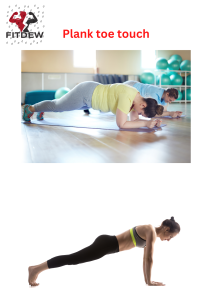
How to carry out plank toe touches
- Get into the push-up or high plank position. Support your body weight on your hands and stretch your legs out behind you.
- Make sure that your hands are shoulder-width apart and feet are hip-width apart. Keep your elbows directly under your shoulders and support yourself on the balls of your feet.
- Keep your head forward and your back straight. Make sure you keep this form throughout your exercise reps.
- Lift your hips, shifting no part of your body. As you do this, stretch your right hand to touch the toes of your left leg. Do this while keeping your back straight.
- Hold this position for one second and then return to the starting position. Reach out your left hand as you simultaneously bend your hips, repeat the process.
Conclusion
With the outline of the different workout at home without equipment, you can select the ones that will suit you more.
But if you require someone to guide you on them you can still get a virtual coach or online tutor to do that for you.
If you have any health condition or issue that you think needs consideration before you engage in any exercise, then talk to your doctor before engaging in these exercises at home.
Editor’s pick
Best 7 exercises to do everyday
8 Best Home Exercises for Weight Loss